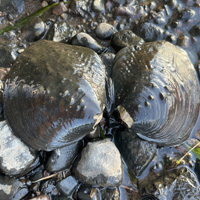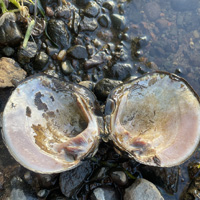Purple Wartyback
Scientific name: Cyclonaias tuberculata


Photo credits: Nicole Michel CC BY 4.0
Status
Threatened
“Threatened” means the species lives in the wild in Ontario, is not endangered, but is likely to become endangered if steps are not taken to address factors threatening it.
Date added to the Species at Risk in Ontario List
January 25, 2023
Read the assessment report (PDF)
What it looks like
The Purple Wartyback is a medium-sized, heavy-shelled freshwater mussel that can reach a maximum size of 20 cm. Juveniles are often yellow or yellow-green with fine green rays along the shell. In adults the colour is often yellow-green progressing to a reddish-brown, and the rays are usually lost.
The exterior of the shell is covered in many pustules (raised bumps), concentrated on the posterior (rear) of the shell and extending onto the beak (the raised area on the top shell, nearby where the shell hinges). The interior of the shell (the nacre) is usually purple and has heavily serrated teeth. In Canada, adults reach a maximum length of 200 mm.
Where it lives
Purple Wartyback can be found in small to large rivers with different types of substrates, including:
- cobble
- gravel
- mixed gravel
- sand
The rivers they occur in typically have moderate to swift currents. The adults burrow into the substrate and are usually found in areas with water depths ranging from 0.6 meters to six meters. The adults are typically found at the surface of the substrate during the summer months but burrow deeper during the winter, while the juveniles spend their first few years completely buried. Larvae are free-swimming and parasitize fish, meaning the species requires a host fish to complete part of its lifecycle.
Historically, the Purple Wartyback was widespread throughout eastern North America, being found in 20 American states and one Canadian province. The historical distribution ranged from southwestern Ontario south to Mississippi, east to North Carolina, and west to Oklahoma. It is thought to be extirpated from Pennsylvania and South Dakota.
Where it’s been found in Ontario
In Ontario, the Purple Wartyback is found within the Great Lakes – Upper St. Lawrence National Freshwater Biogeographic Zone. This species has been observed in southwestern Ontario in the Ausable, Sydenham and Thames Rivers.
What threatens it
The biggest threats to the Purple Wartyback in Ontario are:
- pollution from agricultural effluents
- domestic and urban wastewater
- climate change
- severe weather
Freshwater mussels are sensitive to elevated levels of phosphorus, nitrogen and agricultural waste products. The three southern Ontario watersheds where this species is found are predominantly agricultural with high amounts of agricultural run-off. Occupied rivers are also exposed to domestic and urban wastewater, and exposure to these pollutants are likely to increase as urban development continues.
Another threat the Purple Wartyback faces is from the effects of climate change. Freshwater mussels have been identified as a group likely to be highly impacted by climate change in Ontario. This is partly because of their sessile (attached to substrate and mostly non-moving) nature and dependence on other animals to complete their life cycle. Climate change can cause an increase in the frequency and severity of severe weather events, which can also negatively impact this species.
The introduction and spread of invasive species, such as Zebra Mussel and Round Goby, also pose a threat to the Purple Wartyback.
Action we are taking
This species and its habitat are protected under Ontario’s Endangered Species Act, 2007 (ESA).
The ESA also requires the preparation of recovery guidance for threatened species such as Purple Wartyback to guide recovery efforts for the species in Ontario.
All species listed on the Species at Risk in Ontario List may be eligible for consideration for government funding through the Species at Risk Stewardship Program.
What you can do
Report a sighting
Submit your observations of species at risk to the Natural Heritage Information Centre (NHIC), which is Ontario’s conservation data centre. Join the “(NHIC) Rare Species of Ontario” project in iNaturalist to make submitting your observations quick and easy.
Volunteer
Volunteer with species at risk programs, such as community science surveys, through your local nature club, a provincial park or other conservation organizations.
Be a good steward
- Private landowners have a very important role to play in species recovery. If you find species at risk on your land, you may be eligible for stewardship programs that support the protection and recovery of species at risk and their habitats, such as the Species at Risk Stewardship Program.
- Invasive species seriously threaten many of Ontario’s species at risk. To learn what you can do to help reduce the threat of invasive species, visit:
Report illegal activity
Report any illegal activity related to species at risk to
Quick facts
- Freshwater mussels in general play an integral role in the functioning of aquatic ecosystems, helping to maintain water quality by filtering sediments, bacteria and algae.
- Purple Wartyback are obligate parasites, meaning they cannot complete their life cycle without a period of encystment (the process by which larvae become enclosed in a cyst) on a fish host. The fish hosts of Purple Wartyback are believed to be Channel Catfish, Black Bullhead and Yellow Bullhead.